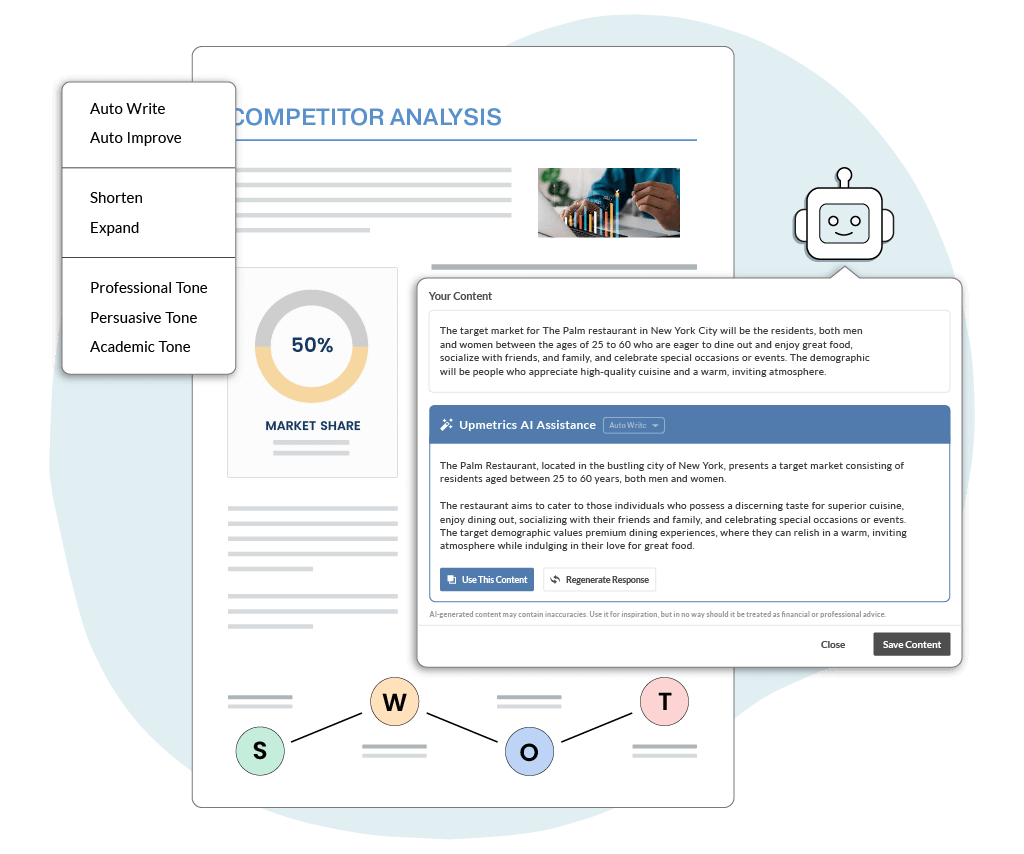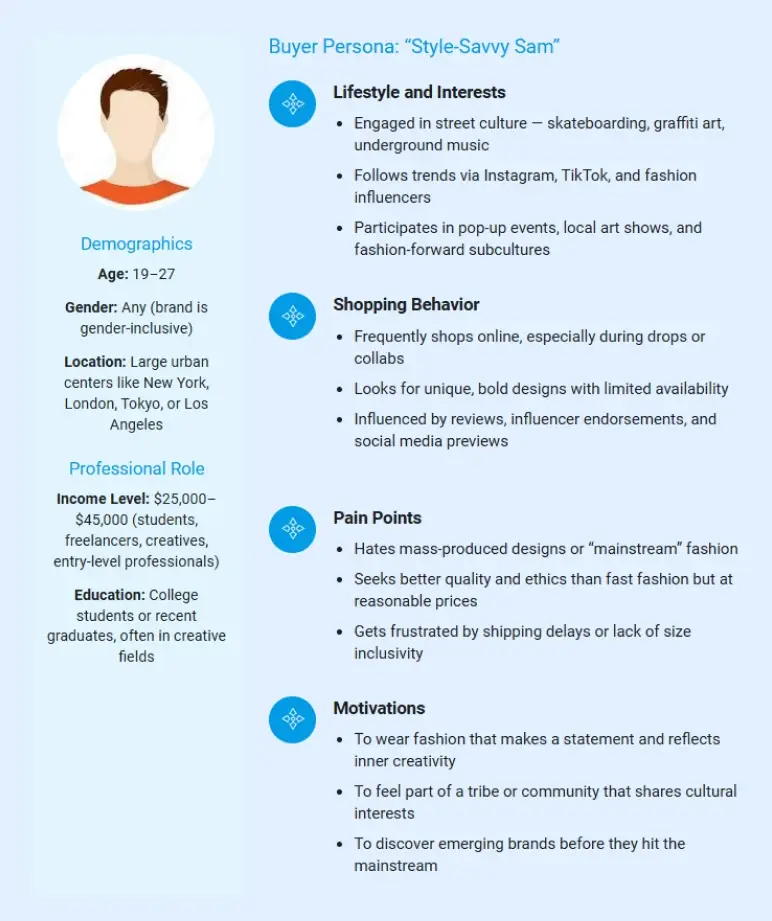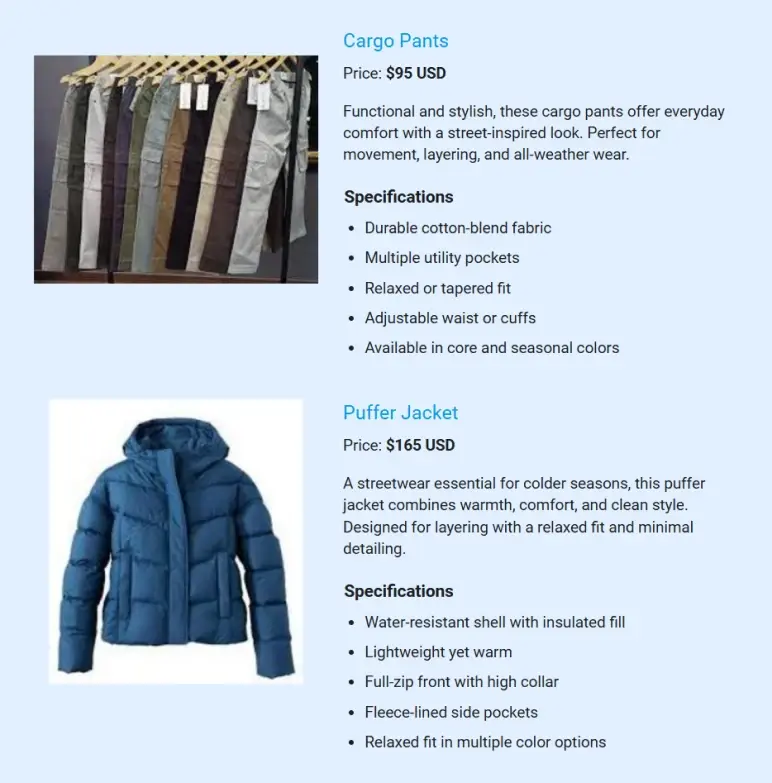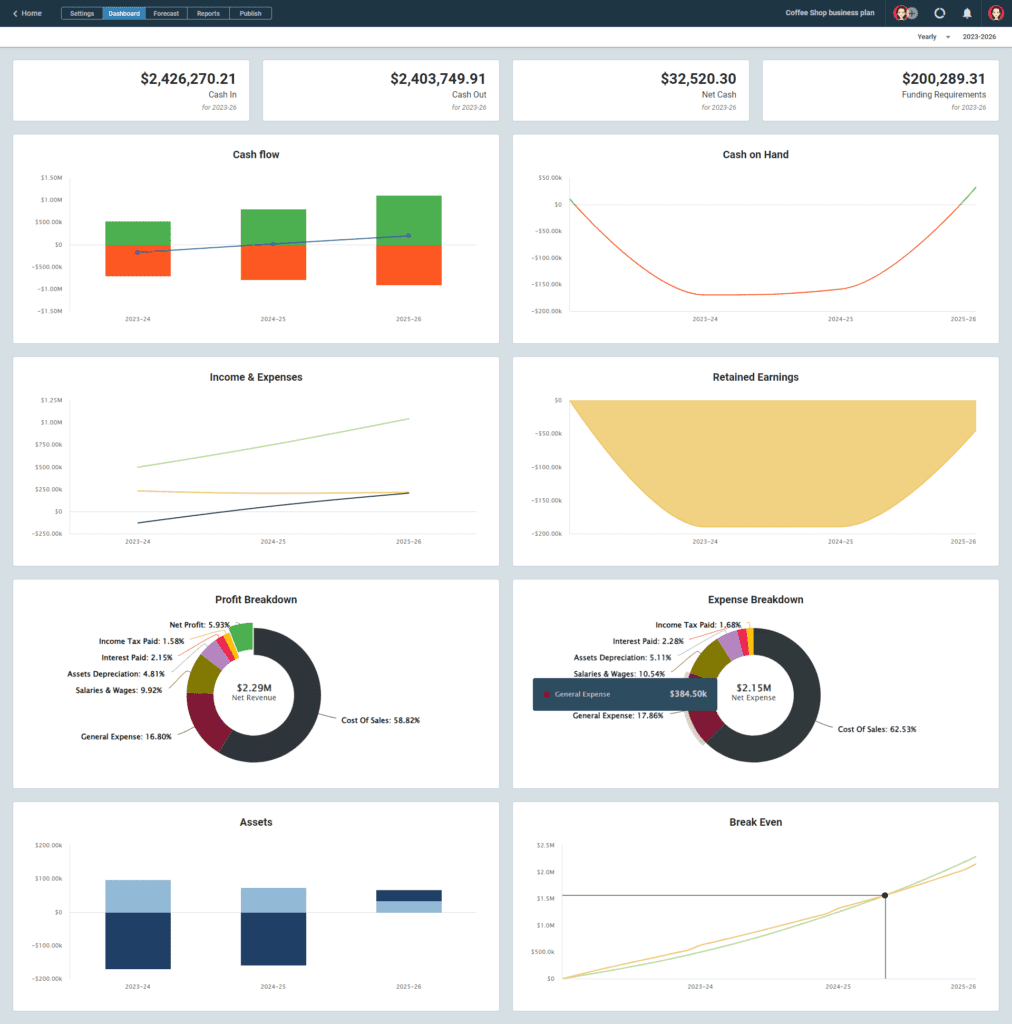Want to transform your passion for fashion and garments into a profitable business venture?
Well, it takes a lot more than a few sketches, threads, and sewing machines to start your clothing store.
The trillion-dollar clothing industry is growing rapidly and the competition is severe to get your brand recognized.
But hey, the odds of you creating a successful clothing business can be increased substantially, just by planning through it thoroughly.
A well-crafted realistic clothing line business plan accounts for every minute detail that goes into establishing a business. Right from market research to financial forecasting and everything in between, it contains details that will help you lay clear future plans for your clothing line.
This is the ultimate business planning guide for anyone who wants to venture into a fashion business and taste the sweet nectar of success.
Let’s power you with all the right resources to write a business plan.
Let’s get started.
Key Takeaways
- Identify your company’s mission, vision, core values, and business objectives and determine your position in the market.
- Identify the latest trends in the fashion industry and how the business will adapt to those trends.
- Prepare for the casualties and mitigate the business risks with a forward-thinking business plan.
- Create a well-structured cohesive business plan with enriching visual reports.
Benefits of having a clothing line business plan
From fashion designers to small businesses and large retail stores, every clothing business requires a clothing line business plan. Wondering why?
Let’s unravel the benefits of having a business plan:
- A business plan accounts for all sorts of emergencies and unknown variables. It prepares you to mitigate business challenges strategically.
- A business plan helps quantify the goals and important business strategies. It gives strategic direction to your business’s core objectives.
- A business plan allows you to review the financial aspects of owning a clothing store. You have a chance to modify the structure, core offerings, and strategies while the idea is still on the paper.
- A business plan adds structure to your everyday operational processes. We all know how seamless operations play a key role in reducing business expenses and costs.
- It helps establish the viability of your business model in the long term and helps make it profitable.
- Last but not least, it helps you acquire investor funding for your dream project.
Convinced, right? Now, let’s understand the basics of creating a clothing line business plan that will help accomplish future plans for your business.
Say goodbye to boring templates
Build your business plan faster and easier with AI
Plans starting from $14/month

Key components of a clothing business plan
Wondering what goes into making a clothing line business plan? Well, here are the key components you would not want to miss adding to your plan.
- Executive Summary: This is a concise summary of your business plan that briefs the reader and engages them for further reading. Make it brief, quick, and meaningful.
- Company Overview: This is a brief description of your company describing its legal structure, ownership, and future goals.
- Market Analysis: This section offers a thorough analysis of the target market, trends, competitors, market size, and business growth potential.
- Products & Services: A line down of your core products and services, their benefits, and unique features that will help you make a profitable business.
- Marketing and Sales Strategy: This section of a business plan introduces various marketing and sales strategies for your boutique business.
- Organizational Structure: This section introduces the key management members of your clothing company and their hierarchy in the organization. Also highlight their expertise, experience, and roles and responsibilities in your business.
- Supply Chain & Operations Plan: Clearly outline the business processes for everyday activities that run your business. Include every detail concerning vendor management, stock policies, employee training, delivery methods, etc.
- Financial Projections: Determine the viability of your clothing business by making financial assumptions. Use forecasting tools to make precise calculations and projections.
Let’s move forward and understand the detailed process of writing a business plan.
A step-by-step guide to creating a clothing line business plan
You are already aware of the key components that go into making a solid business plan. Now, let’s get you a breakthrough in the fashion industry with a detailed guide on creating a fashion brand business plan.
1. Get a business plan template
Before you start writing a business plan for your clothing brand, do yourself a favor and pick a business plan template to simplify this entire process.
This is because writing a business plan from scratch is challenging. It includes too many components and addressing each of them with utmost clarity gets taxing.
A template offers a structural framework to your plan and helps maintain clarity in the way you present the information. It streamlines the entire process and makes it easy for you to update and modify the plan as needed.
Now, don’t look elsewhere searching for the perfect template. The Upmetrics intuitive and relevant business plan templates are available for free download and easy edits.
Whether yours is a startup clothing line or a clothing boutique, Upmetrics has plenty of fashion industry business plans to choose from.

Pro-tip
Need Assistance Writing a Clothing Line Business Plan?
Get Upmetrics’ business plan template, import data directly into the editor, and start editing using Upmetrics AI Assistant.

2. Write an executive summary
It is a concise and well-structured summary of your entire business plan that compels potential investors to know more about your clothing brand.
Avoid the fluff and be catchy with the business description here.
The executive summary must contain details like the location of your clothing business, products you sell, market opportunities, business strategy, and anything that makes your fashion business a huge sell.
Also, don’t forget to add a relevant CTA for the readers. Let them know what you wish to achieve with this business plan.
Adopt a storytelling approach and find the hook to capture anyone reading your business plan.
For example:
Seine is an online apparel retail brand that brings ethically sourced fashion to the market. We are focusing on a target demographic of women in their twenties and thirties who want to build a basic capsule wardrobe with sustainable timeless pieces. After generating a million-dollar business through our online clothing store, we now plan to launch our physical clothing stores in three different locations: New York, London, and Delhi. We are looking for funding to expand our operations and grow our prominence through offline stores.
Now, an executive summary is the first and most important part of your business plan. However, we recommend writing it towards the end once you are done with your financial projections.
3. Prepare a company overview section
Company overview is a brief business description of your fashion brand. It is your chance to describe your own clothing business in the most compelling and natural way possible.
Describe what kind of clothing business you are planning to open, i.e. retail store, a chain of fashion brands, clothing boutiques, clothing department stores, or some unique fashion business. Mention the owner of this clothing brand and their prior experience in the fashion industry.
Also, mention the legal structure of retail stores. Mention if it will be a limited liability company or a partnership firm.
This section should be insightful for potential investors and must include your mission statement, business goals, and company values.
Here’s what these key indicators should include:
Mission statement: A brief statement describing the reason you are starting this clothing brand. It must explain the reason for a clothing brand’s existence and its purpose.
Business Goals: What are the aspirations and vision for your fashion brand? It can include quantitative goals like, the number of retail stores, revenue goals, ranking, number of cities, etc.
It can also include qualitative details like being the most recognized ethical fashion brand.
Company values: Think of core values that define your clothing brand and influence the decisions.
Core values are what separates your brand from different apparel brands.
4. Conduct a fashion industry market analysis
A market analysis is essential to distinguish your business from competing clothing lines.
This part of a business plan includes a detailed understanding of the target market, competitors, market size, future growth potential, emerging market trends, and much more.
Dedicate a section of the market overview to outline your target demographic. Create a buyer persona taking into consideration the age, gender, income, shopping habits, values, and spending patterns of your target audience. This will help you create ideal products for your audience and devise marketing strategies to reach them.

Identify your direct competitors and analyze the fashion brands and apparel brands working in a similar segment like you. Also, consider the indirect competitors like clothing retailers that offer products at cheaper rates to your target audience.
Further, highlight the scope of growth potential for your clothing business. Enrich this section with statistical data, graphs, and qualitative analysis wherever possible.
Lastly, discuss the emerging trends in your segment. We all know how trends shift in the fashion world. Suggest how your business will address these trends to stay relevant. Also, identify the challenges in current business and suggest a feasible plan to overcome those challenges.
5. Describe your core product line
Now that your mission statement and market analysis are in place, it’s time to introduce your products and services to potential investors.
In this section of a business plan, offer a brief rundown of all the products and services that will be sold by your clothing business. Mention the features and benefits that make your products desirable.

Take this opportunity to highlight the product USP’s that separates your clothing line from other clothing lines.
Draft this section from an investor’s point of view. Consider the questions they might have regarding the product and write accordingly.
For instance,
- Will you sell cloth semi-finished garments or readymade garments?
- Will you manufacture the garment or sell it through a retail business?
- Are there any special features of your product: Sustainably grown, ethically sourced, single thread sewing, water repellent fabric, etc..
- Is the customization option available on your products?
Overall, this section should convince the investors of the viability of your product.
6. Propose marketing and sales strategies
Now that you have finalized the products and services, how do you propose to sell them?
Sales is at the root of business success and marketing is what fuels the sales. So, now you need appropriate strategies in place to achieve your business goals.
Consider answering the following questions to help you form a sales strategy:
- What is your annual sales goal?
- How do you intend to bring sales: online clothing store, retail store, or through a mix channel?
- What is your pricing strategy for products?
- How much annual revenue do you plan to generate?
- How much money do you need to invest to generate sales?
Once your sales strategy is in place, you start working on your marketing strategy.
Keep in mind that the fashion industry is huge. A different marketing plan is required for different types of fashion businesses.
Conduct market research into your target demographic and determine your marketing strategy. Identify rewarding marketing channels and allocate your budget for each of them.
A marketing plan of clothing line can include a mix of paid and organic marketing strategies. Consider adding print advertising, social media marketing, Email marketing, Google ads, content marketing, and other marketing strategies to your clothing business plan.
7. Introduce leadership or management team
In this part of the business plan, introduce the key personnel who will manage your clothing line. This can be CEOs, owners, key managers, business leaders, or consultants who will shape the business with their expertise.
Include a brief biography of key members and mention their relevant experience in the industry. Also, highlight the hierarchy of these key members in your organization and their roles and responsibilities.
Lastly, mention the cost of acquiring, training, and retaining your management team.
Overall, this section of a business plan should focus on proving the asset-worthiness of these members.
8. Outline your operational plan
How do you plan to run a clothing store once you acquire the funding? Have you given a thought about everyday challenges, operations, and processes?
In this section of a business plan, you will explain the business operations of your clothing store in great detail.
Include the following brief details while outlining your operational plan:
- Manufacturing or Retailing: Will your clothing store have its own manufacturing or perform as a retail store? If you manufacture your own garments, will you have your own production units or get them manufactured by a third party?
- Online selling: Will the clothing store sell online? If so, will you use your own website or a seller’s platform? Highlight the entire online ordering process starting from inquiry management to sales and after-sales.
- Inventory management: Where will you store the goods? Who will be responsible for managing the inventory? What software and tools you will use to track the goods?
- Vendor management: Who will be your vendors? Do you have any agreements with them?
- Logistics: Who will be your logistics partner? What will be your shipping policy? What will be the delivery methods and charges?
Include every little detail you can think of. Whenever confusion regarding business processes arises, this operations plan should serve as a roadmap.
9. Create a financial plan
If you are looking for investor funding, the financial plan is where the investors’ interest lies. It is usually demonstrated in figures, graphs, charts, and Excel sheets.
A financial plan must include different financial statements for your clothing line business. For example, income statements, cash flow statements balance sheets, break-even analysis, and investment statements.
Follow this step-by-step guideline to write this financial plan section effectively:
- Identify the costs of starting a clothing line business. Consider various one-time expenses and recurring expenses and get precise estimates.
- Assess your current monetary position and determine how much funding is essential to get started. Pick a suitable funding strategy by identifying different funding sources, i.e. bank loans, angel investors, SBA loans, personal loans, etc.
- Make pre-assumptions based on market research and analysis. It is time to make financial projections and form pricing strategies, sales forecasts, and overhead budgets for your clothing business.
- Using the projections made earlier, form key financial statements of your business for the next 3-5 years.
- Test assumptions for different scenarios and use methods like sensitivity analysis to make your projections more relevant.
- Mention the monitoring and review methods you will use to review the finances of your business.
Now, doing all these from scratch will take months. And still, there will be higher chances of errors in your calculations.
A financial forecasting tool can be of utmost help here. Simply enter the sales and cost figures and it will make all essential calculations for monthly, quarterly, and yearly reports. Creating a financial plan in Snap is truly possible.
The financial plan is a snapshot of your clothing business. Make sure you draft it with clarity.
10. Include informative graphics and visuals to present data
We have discussed the key fundamentals of a business plan by now. But do you feel that your clothing line business plan is lacking character? It’s possibly because it’s all pages and pages of text in there.
A business plan must be enriched with derivative graphs, visuals, and infographics to make it interactive and appealing. Moreover, the figures and data are easily digestible when they are presented in the form of visual reports.
If you have been writing a business plan using Upmetrics, the tool already made a visual report when you complete writing the financial plan. Don’t believe us? Go and check your dashboard.
Here’s a glimpse into the Upmetrics dashboard.

Now, if you wish you can add more elements of visuals to your plan. Identify different opportunities where you can present the information visually.
And that’s pretty much it. By the end of these steps, you will have your fashion brand business plan ready.
Clothing Line Industry Highlights 2025
Trends in fashion shift faster than reels on TikTok. From new shopping habits to rising sustainability trends, here’s what’s happening in the clothing world right now:
- The global luxury fashion market is on the rise. It’s expected to reach $116.16 billion in 2025, up from $109.42 billion in 2024.
- Sustainable fashion is growing even faster. It’s valued at $12.46 billion in 2025 and could hit $53.37 billion by 2032, growing at over 23% each year.
- In the U.S., shoppers are spending around $365.7 billion on clothes this year. That number is expected to go up slowly, about 1.8% each year
- Women’s apparel remains the largest segment, with $195.2 billion in U.S. sales alone.
- Most people now use mobile apps to shop. About 88% of shoppers have at least one app on their phone. Half have more than four, and 9% have over ten.
- More than 60% of Gen Z prefer brands that offer gender-neutral clothing. This market is worth around $50 billion in 2025, and is expected to grow by 15% from 2025 to 2033.
The bottom line? The clothing industry is moving fast. If you want your brand to grow, keeping up with what people care about—and how they shop—is key. The brands that listen are the ones that stand out.
Refine and present a Clothing Line Business Plan
After writing the first draft of your clothing line business plan, keep it aside for a few days. This will make editing more effective.
Now, proofread the entire document. Read, re-read, and edit till you find the contents to be an exact representation of your business.
It is also advisable to edit your business plans for different audiences. This will improve the efficacy of your plan and increase its relevancy amongst different stakeholders.
For example,
If you are planning to procure funding from investors, keep the format professional and focus on presenting financial data for growth, profitability, and ROI. However, your business plan should focus on partnership details and collaboration benefits when presented to retailers and suppliers.
Ensure that important data is represented through graphs, visuals, and appealing charts. Incorporate a storytelling approach to make the content interesting.
Before sending it across, ask a friend, relative, or professional colleague to review it critically and make essential changes.
Once you are confident about the presentation, share it with the potential stakeholders.
Download a Sample Clothing Line Business Plan
Need help planning the contents of your business plan? We have a perfect resource for you. Download our free clothing line business plan pdf and get step-by-step instructions with all the industry-relevant examples.
Upmetrics intuitive templates are specifically designed for business enthusiasts and entrepreneurs who are ready to kickstart their business planning. Simply import the data into the editor and start planning.
The Quickest Way to turn a Business Idea into a Business Plan
Fill-in-the-blanks and automatic financials make it easy.
Write Your Business Plan With Upmetrics
Streamline your business planning process with Upmetrics. With more than 400+ customizable sample business plans, Upmetrics offers AI assistance and step-by-step guidance to write a cohesive business plan.
Whether you are expanding your current business or setting up a start-up, Upmetrics resources will help you create an actionable and forward-thinking business plan in easy steps.
Let’s bring your clothing line dream into reality.



